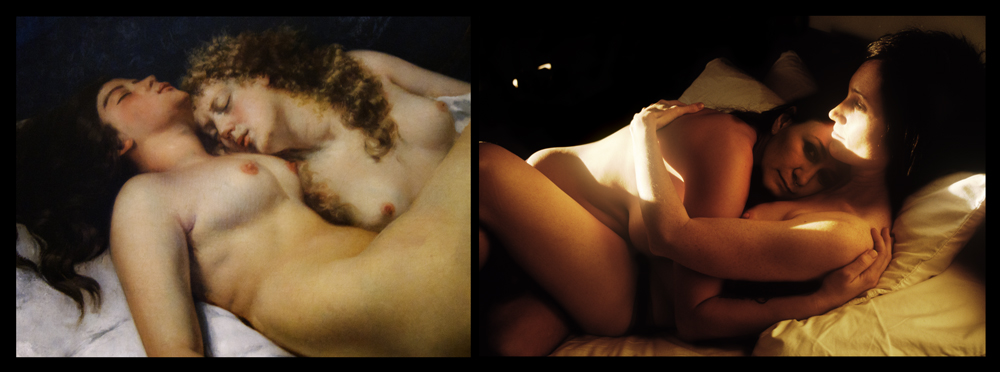Single-handedly, Scopophilia, the 25-minute slideshow and centerpiece of Nan Goldin’s show at the Matthew Marks Gallery show generates empathy for Goldin’s subjects, those demi-monde friends appearing in alternating states of intimacy and quiet dysfunction. For about half an hour, the transgressive vulgarisms associated with her work are forgotten. Instead, viewers experience a pastiche accompanied by a liberating soundtrack and the juxtaposition of images typical of her aesthetic with ethereal masterpieces depicting eternal devotion, love and tenderness.
By pairing harmony with pathos and the impalpable with the palpable, we are given reasons to care about the fates of all of Goldin’s men and women, both past and present. More significantly, the corporeality in Goldin’s work suggests a departure from a static, myopic world into one where connectedness is sought, relationships are healthy and touch is of a soft variety. Goldin, the woman, seems to have embraced humanity, an uplifting prospect for those familiar with her work.
Scopophilia continues across three galleries, as nearly fifty mounted thematic photographs, including Hair, Water, Crazy Scary, Odalisque and Veiled, shown as “mosaics.” It’s impossible not to ask what was awakened in the artist to have selected the works she paired with her autobiographical subjects beyond scopophilia, the pleasure of looking. Curatorially, the show would have benefited from the introduction of a narrative–think e-readers with anecdotes illuminating the new perspective of the artist.
Diptychs like The Horse Races, Egypt; Sisters; The Nap; Swan-like Embrace; Pygmalion and Galatea were more studied, and validate her self-described desire to understand people as opposed to being a voyeur or narcissist. Sisters is the finest among them with its asymmetrical composition and ethereal light highlighting the angelic qualities of the modern girls, their slight Roman noses mirroring those of their classical sisters.
A portrait in the round gallery paired Louvre paintings with Goldin subjects, one atop the others such as Diana the Huntress (1550/60) with Valerie, London (2003). Indeed, the story about why these images are paired (one of the images is part of her personal mythology) meets the challenge posed by Patrice Chéreau. Yet by accepting his invitation to participate in “Faces and Bodies” the cross-disciplinary program which ran through January 2011 at the Louvre, Scopophilia becomes evidence that Ms. Goldin achieved a detectable amount of transcendence from an earlier body of work.
Light moves slowly between the galaxies according to physicist Paul Davies. Scopophilia gives us the sense that Goldin has been exposed to a light more poetic than scientific, and, more important, more hopeful.




 RSS
RSS
